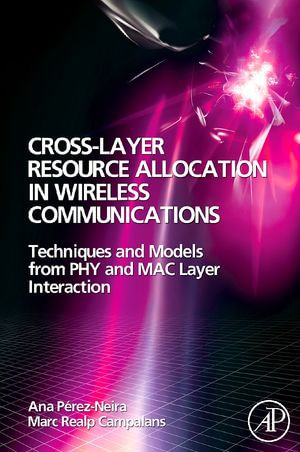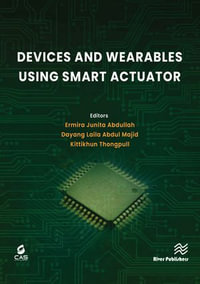
Cross-Layer Resource Allocation in Wireless Communications
Techniques and Models from PHY and MAC Layer Interaction
eText | 28 July 2010
At a Glance
eText
$119.90
or
Instant online reading in your Booktopia eTextbook Library *
Read online on
Desktop
Tablet
Mobile
Not downloadable to your eReader or an app
Why choose an eTextbook?
Instant Access *
Purchase and read your book immediately
Read Aloud
Listen and follow along as Bookshelf reads to you
Study Tools
Built-in study tools like highlights and more
* eTextbooks are not downloadable to your eReader or an app and can be accessed via web browsers only. You must be connected to the internet and have no technical issues with your device or browser that could prevent the eTextbook from operating.
Resource allocation in wireless networks is traditionally approached either through information theory or communications networks. To break down the barriers between these distinct approaches, this book (whose preparation is carried out under the auspices of the EC Network of Excellence in Wireless Communications NEWCOM++) bridges the physical and network layers by providing cross-layer resource allocation techniques, models and methodologies.
Cross-Layer Resource Allocation's unique approach allows optimisation of network resources and will enable engineers to improve signal quality, enhance network and spectrum utilization, increase throughput, and solve the problem of shadowing. Topics covered include different views of spectral efficiency, the role of spatial diversity, of delay in resource allocation, and possible extensions to OFDMA systems.
This will be an ideal reference on cross-layer resource allocation between the PHY and MAC layers for R&D and network design engineers and researchers in universities dealing with sensor networks and cognitive systems.
"This is a nice treatise on the cross-layer optimization of wireless systems. The authors offer a useful guide on a timely subject most relevant to future generation of wireless communications." - Lang Tong, Irwin and Joan Jacobs Professor in Engineering, School of Electrical and Computer Engineering, Cornell University, USA
"The authors have written a book that offers to researchers and practitioners a thorough and comprehensive overview, with a cross-layer perspective, of theory, models and methods related to resource allocation in multi-user wireless systems." - Professor Velio Tralli, University of Ferrara Communication Technologies Laboratory
Ana I. Perez-Neira is Professor of Signal Theory and Communication at Technical University of Catalonia (UPC), Barcelona, and Research Associate at Centre Tecnologic de Telecomunicacions de Catalunya Castelldefels (CTTC).
Marc Realp Campalans has worked as a Research Associate in the Access Technologies Area at CTTC since 2002.
* Gives a full description of the characteristics of the PHY layer that promote efficient resource allocation strategies
* Gives special emphasis on cross-layer design for spatial diversity schemes
* Provides a framework for interaction between the PHY and MAC layers, their parameters of performance and their relationship
* Presents resource allocation as a cross-layer design based on an optimization of MAC layer parameters with an accurate model of the PHY layer
Cross-Layer Resource Allocation's unique approach allows optimisation of network resources and will enable engineers to improve signal quality, enhance network and spectrum utilization, increase throughput, and solve the problem of shadowing. Topics covered include different views of spectral efficiency, the role of spatial diversity, of delay in resource allocation, and possible extensions to OFDMA systems.
This will be an ideal reference on cross-layer resource allocation between the PHY and MAC layers for R&D and network design engineers and researchers in universities dealing with sensor networks and cognitive systems.
"This is a nice treatise on the cross-layer optimization of wireless systems. The authors offer a useful guide on a timely subject most relevant to future generation of wireless communications." - Lang Tong, Irwin and Joan Jacobs Professor in Engineering, School of Electrical and Computer Engineering, Cornell University, USA
"The authors have written a book that offers to researchers and practitioners a thorough and comprehensive overview, with a cross-layer perspective, of theory, models and methods related to resource allocation in multi-user wireless systems." - Professor Velio Tralli, University of Ferrara Communication Technologies Laboratory
Ana I. Perez-Neira is Professor of Signal Theory and Communication at Technical University of Catalonia (UPC), Barcelona, and Research Associate at Centre Tecnologic de Telecomunicacions de Catalunya Castelldefels (CTTC).
Marc Realp Campalans has worked as a Research Associate in the Access Technologies Area at CTTC since 2002.
* Gives a full description of the characteristics of the PHY layer that promote efficient resource allocation strategies
* Gives special emphasis on cross-layer design for spatial diversity schemes
* Provides a framework for interaction between the PHY and MAC layers, their parameters of performance and their relationship
* Presents resource allocation as a cross-layer design based on an optimization of MAC layer parameters with an accurate model of the PHY layer
Read online on
Desktop
Tablet
Mobile
ISBN: 9780080920887
ISBN-10: 0080920888
Published: 28th July 2010
Format: ePUB
Language: English
Number of Pages: 192
Publisher: Elsevier S & T
You Can Find This eBook In
This product is categorised by
- Non-FictionComputing & I.T.Computer Networking & Communications
- Non-FictionEngineering & TechnologyEnergy Technology & EngineeringElectrical Engineering
- Non-FictionEngineering & TechnologyElectronics & Communications EngineeringCommunications Engineering & TelecommunicationsWAP & Wireless Technology
- Non-FictionEngineering & TechnologyElectronics & Communications EngineeringCommunications Engineering & TelecommunicationsTelephone TechnologyMobile Phone Technology
- Non-FictionEngineering & TechnologyElectronics & Communications EngineeringCommunications Engineering & Telecommunications























